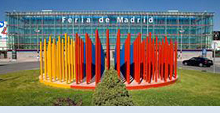 |
European Planetary Science Congress 2012
IFEMA-Feria de Madrid
23 – 28 September 2012, Madrid, Spain |
 |
Location
The European Planetary Science Congress 2012 will take place at the IFEMA Fair Center in Madrid (North Cenvention Center, Vestibulo Este).
Madrid (population around 5 million), the capital of Spain, is situated south of the "Sierra de Guadarrama" that tower 2,100 meters above sea level, and where the banks of the Manzanares river flow past the westernmost part of "the City", as Madrid is known to locals. Madrid's climate is temperate, cooled by the mountain breezes during Spain's hot summers. Its palaces, numerous museums and art galleries provide a feast for modern culture lovers. The City also prides itself on a vibrant nightlife.
View Larger Map
How to reach Madrid
Barajas International Airport
All flights to/from Madrid arrive/depart from Barajas International Airport. It has four terminals (T1–T4): Domestic flights (3), International flights (2), countries from Schengen treatise (2).
- Info telephones: +34-902-353570; +34-91-3058343; +34-91-3058344; +34-91-3058345.
- Parking: guarded 24 h. Price: €1.30 for one hour; €11.35 for 24 hours.
- Airport by bus: regular line connecting airport and Plaza de Colón (see map of center of Madrid or detailed map) every 10–15 min., from 5:45 am to 9:30 am. It takes 1/2–3/4 h or even 1 h during rush hours. Tickets: €3 approx. From Plaza de Colón you can connect to any point of Madrid by Metro.
- Taxis: typical price €20 approx. Taxis only at the taxistand.
- Car: all car rental offices can be found at the airport.
- Metro: Line 8 of the Metro ends at Barajas Airport. Price: €1.50, single; €9.10 tickets. Open from 6:00 am to 1:30 am. Fast connections with the city center: 20 min. (5 underground stations). Line 8 is also the line to the Campo de las Naciones underground station (circle in red in the attached plan) where the IFEMA Fair Center is located.
Train
Trains coming from outside Spain and from the south, east and west arrive at Atocha. Trains coming from the north arrive at the Chamartín Railway Station. Info telephone: +34-902-240202. You can reach Atocha and Chamartín by Metro (Atocha Renfe and Chamartín stops). Timetables, destinations and ticket prices can be found at the RENFE website. This company also controls suburban trains (see map).
Bus
Bus transportation is the least expensive within-Spain travel option. The main bus station (long distances) is Estación Sur de autobuses, near the Atocha Railway Station (Méndez Álvaro metro stop).
Car
Madrid has six principal highways (N-I to N-VI) and two ring roads (inner: M-30, outer: M-40)
- Burgos: also known as 'Autovía del Norte', connects Madrid with Burgos, Cantabria or País Vasco and it is the route to France.
- (Barcelona: connects Madrid with Guadalajara, Zaragoza, Barcelona and Costa Brava. It is also the way to travel to the south of France (La Junquera).
- Valencia: connects Madrid with Cuenca, Albacete, Murcia and the Mediterranean cities Alicante (Costa Blanca) and Valencia y Castellón (Costa del Azahar).
- Andalucía: connects Madrid with the south of Spain: Ciudad Real, Jaén, Córdoba, Sevilla, Granada, Almería, Málaga, Cádiz, Jerez de la Frontera, and Tarifa, and with some touristic destinations (Costa del Sol, Costa Cálida) as well as with Gibraltar and the ferries that travel to Marruecos.
- Extremadura: it is the route to travel to Talavera, Trujillo, Cáceres, Mérida, Badajoz, and to Portugal (Lisboa, Algarve). It is also an alternative to travel to west Andalucia.
- A Coruña: connects Madrid with the north-west cities of El Escorial, Segovia, Avila, Salamanca, Valladolid, Zamora, León, Galicia, and Asturias and the north of Portugal.


